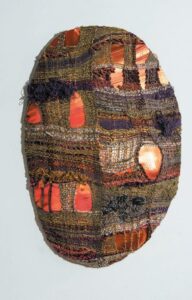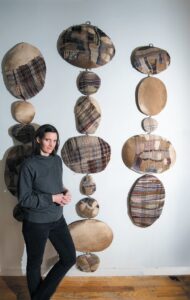Juliet Martin is a versatile fiber artist who creates sculptural woven and sewn forms that can be seen in her exhibit, “I Would Wear That.” She employs earth-toned yarn, some of which is loomed into tapestries that are then cut-up and reassembled in elliptical forms using canvas, velvet and metallic cloth as anchors for the weaving.

“Formalwear” Juliet Martin
Martin demonstrates a sardonic sense of humor in the titles she chooses for her work. She says, “’ I Would Wear That’ is a collection of handwoven wall hangings. Their only function is to look nice. I wove with colors I like to wear. They belong on the wall, not in my laundry basket. I wish my closet looked like this.”
She says her work adheres to the Japanese Zen philosophy of Saori, where it is free form, without rules or mistakes, flowing as an improvisation with its resulting imperfections in the product—raggedness and roughness—coalescing in what the artist calls “awkward beauty” and harmony. Her choices of earthy, natural colors give these abstract wall hangings eloquent complexity. The warp and weft become part of the fiber design, integrating the framework of the piece into an organic, textured whole, evoking nature. Although the ideas of Saori do not ascribe referent meaning, to this viewer, the pieces conjure up a rich, dark forest, the splintery tree barks of rotted out logs falling across the forest floor, with subtle, warm umber yarns underscoring this feeling.
Some of the pieces in the show are more tightly woven than others. Contrasting with the forms that exhibit open areas in the weaving, allowing the anchoring, rounded backgrounds to show through, Martin also closely weaves her yarn into dense cloth and juxtaposes it with a profusion of looped yarn, protruding from the forms. This technique, tactile and pleasing, causes me to want to run my fingers through the loops, as if I were touching the wooly coat of an animal.
The artist’s inventiveness is wonderfully demonstrated in the woven ellipses vertically joined together, cascading down the wall in almost archaic compositions. Although Martin presents a public demeanor that is somewhat humorous when she describes her work, the simplicity of the sculptural forms and the organic weaving create a sense of timelessness and seriousness, with an almost shamanic aura.

The title of this show, in actuality, indicates more than humor. The work exhibits profundity in the images evoked of early history, where wearing woven cloth, many times held spiritual significance, helping to enact sacred rituals. Perhaps the artist would object, but, these pieces convey much more than sartorial decoration—in Martin’s words, that they “look nice.” They are an embodiment of early human history with meaning more profound than what the artist would admit. The improvisational work of
Juliet Martin brings forth emotive depth to be long-savored.




